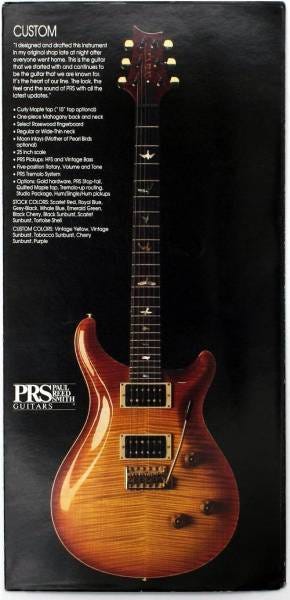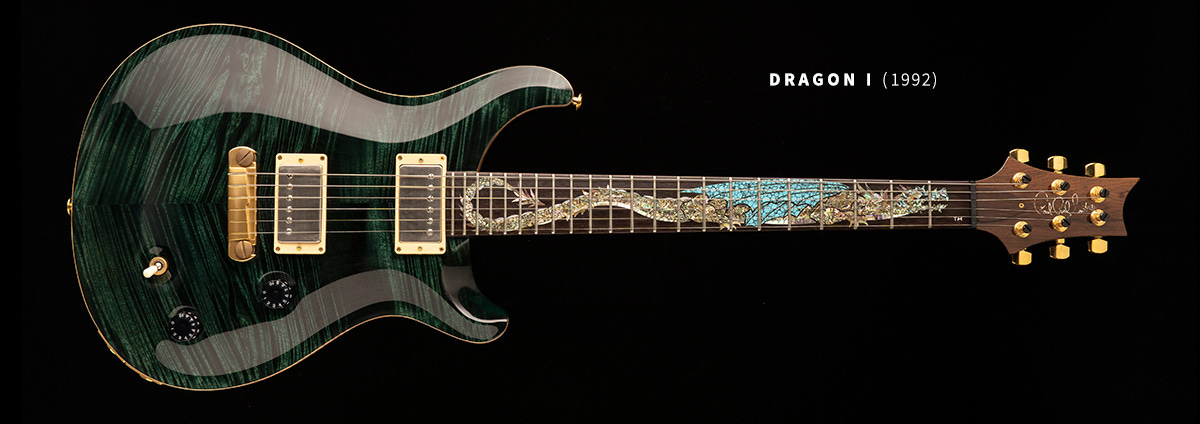Guitar Gavel Lick Of The Week with Stevie K
Steve gives us the basic structure for a call and response using the key of A7. “He with the biggest vocabulary on the guitar wins!” Thank you Steve for your time, talent, and sharing of your gifts.
A 16-year-old Paul Reed Smith had a dream about a dragon inlay on the fretboard of a guitar. He waited patiently for twenty more years before an affordable technology evolved to make his dream a reality.
It was also at the age of sixteen that Smith began building his own instruments and found employment at his local guitar shop in Bowie, MD as a repairman. He continued to build guitars on the side as he attended St. Mary’s College, a declared math major, following in the footsteps of his dad who was a Navy mathematician and his mom who taught elementary school math. Smith even talked his music professor into letting him build a guitar from scratch for class credit.
Two seminal moments occurred in college that made him determined to become a professional guitar builder. The first was gaining notoriety as a guitar tech by repairing Danny Gatton’s Les Paul Junior that was once owned by Joe Perry. The second was an “aha moment” during a Johnny Winter concert that being a guitar builder was his destiny.
Smith dropped out of college to pursue his repair and custom guitar business by setting up shop in his parent’s home. The first big name commissioned guitar went to Ted Nugent in 1975, followed by Peter Frampton, and then Al Di Meola in 1976. The earliest body styles were based on a Les Paul Junior and remain very similar to the Custom PRS body we all know today.
It was Frampton’s guitar when the signature bird inlays first appeared. In a PRS “From The Archives” podcast Smith describes how they came about, “My mother was a birdwatcher, and I never thought about it. I had this guitar to make and I needed inlays for it. It was never even a thought, I just went down and did it. From thought to inlay was so fast.”
By 1977 Smith’s roster list was quite impressive although he’d only built seventeen guitars. Another major “get” came in 1980 when Smith approached Carlos Santana about a custom guitar for the second time, Santana finally agreed.
By 1985 Smith felt like he had maximized the custom guitar segment, incorporated as Paul Reed Smith Guitars, and raised capital to build a full production shop in Annapolis, MD. The first guitars to roll off the line were the PRS Custom models retailing at a whopping $1,500. This also the first time the elongated bass horn appeared. Despite the outward success, Smith described his company as “fledgling” in the late 1980s when he befriended and mentored under Ted McCarty, the former President of Gibson and leader during the company’s mid-century glory days. Other models of the late 80s included the Standard, Signature, and Bass 4.
Back to that dream from a teenage Smith in 1972… he put pen to paper in 1979 for the dragon inlaid fretboard and waited. It wasn’t until “affordable” CNC technology and laser-sharp cutting techniques came along that his dream became a possibility.
Smith, through a contact at C.F. Martin was introduced to a company called Pearl Works and its founder Larry Sifel. They cut the individual inlay pieces using Larry’s CNC machine, which prior to that would have to be done by hand. Not that it was entirely impossible, just not economical :-). Introduced in 1992, the Dragon I was limited to 50 guitars and was also the first 22-fret PRS. The artwork consists of 201 pieces of abalone, turquoise, and mother of pearl. PRS has since produced eight more limited run Dragon’s with the most recent being a 35th anniversary model in 2020.
1992 Dragon I specs:
-
One-piece mahogany wide-fat set-neck, Brazilian rosewood fingerboard with first-style Dragon inlay.
-
22 frets; abalone inlaid signature on headstock, locking tuners.
-
Solid mahogany body, figured maple top
-
Color options: amber, dark cherry, sunburst, indigo, teal black.
-
Two humbuckers (Dragon Treble & Bass)
-
Volume, Tone, five-way rotary pickup switch.
-
PRS Stoptail







1 comment
Great article. I didn’t know PRS in the late 90’s but I wanted a Dragon so badly. The inlay work was the finest I had ever seen. It made it such a unique instrument. I really didn’t care about the playability as much as I was more interested in it’s appearance.